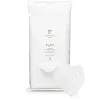What's inside
What's inside
 Key Ingredients
Key Ingredients

No key ingredients
 Benefits
Benefits

 Concerns
Concerns

No concerns
 Ingredients Side-by-side
Ingredients Side-by-side

Water
Skin ConditioningDecyl Glucoside
CleansingAloe Barbadensis Leaf Extract
EmollientCaprae Lac
Skin ConditioningCarica Papaya Fruit Extract
Skin ConditioningAnanas Sativus Fruit Extract
Skin ConditioningAlthaea Officinalis Callus Culture Extract
AntioxidantAvena Sativa Kernel Extract
AbrasiveCucumis Sativus Fruit Extract
EmollientTocopheryl Acetate
AntioxidantUbiquinone
AntioxidantCitric Acid
BufferingPolysorbate 20
EmulsifyingEDTA
Disodium EDTA
Phenoxyethanol
PreservativePotassium Sorbate
PreservativeSodium Benzoate
MaskingWater, Decyl Glucoside, Aloe Barbadensis Leaf Extract, Caprae Lac, Carica Papaya Fruit Extract, Ananas Sativus Fruit Extract, Althaea Officinalis Callus Culture Extract, Avena Sativa Kernel Extract, Cucumis Sativus Fruit Extract, Tocopheryl Acetate, Ubiquinone, Citric Acid, Polysorbate 20, EDTA, Disodium EDTA, Phenoxyethanol, Potassium Sorbate, Sodium Benzoate
Water
Skin ConditioningDipropylene Glycol
HumectantTriethylhexanoin
MaskingAlcohol Denat.
AntimicrobialPEG-7 Glyceryl Cocoate
EmulsifyingPolysorbate 60
EmulsifyingDiethoxyethyl Succinate
SolventOryza Sativa Extract
AbsorbentOryza Sativa Bran Oil
EmollientAloe Barbadensis Leaf Extract
EmollientCaprylyl Glycol
EmollientC12-14 Pareth-12
EmulsifyingHexylene Glycol
EmulsifyingButylene Glycol
Humectant1,2-Hexanediol
Skin ConditioningEthylhexylglycerin
Skin ConditioningCarbomer
Emulsion StabilisingPotassium Hydroxide
BufferingPhenoxyethanol
PreservativeDisodium EDTA
Parfum
MaskingWater, Dipropylene Glycol, Triethylhexanoin, Alcohol Denat., PEG-7 Glyceryl Cocoate, Polysorbate 60, Diethoxyethyl Succinate, Oryza Sativa Extract, Oryza Sativa Bran Oil, Aloe Barbadensis Leaf Extract, Caprylyl Glycol, C12-14 Pareth-12, Hexylene Glycol, Butylene Glycol, 1,2-Hexanediol, Ethylhexylglycerin, Carbomer, Potassium Hydroxide, Phenoxyethanol, Disodium EDTA, Parfum
Ingredients Explained
These ingredients are found in both products.
Ingredients higher up in an ingredient list are typically present in a larger amount.
Aloe Barbadensis Leaf Extract is an extract of the leaves of the aloe, Aloe barbadensis, Liliaceae.
Aloe is one of the most well-known natural soothing ingredients, and for good reason. It’s full of water and has a cooling, calming effect on the skin, especially when it’s sunburned, itchy, or irritated. Aloe also helps your skin stay hydrated and smooth by mimicking what healthy skin naturally produces. On top of that, it contains vitamins and nutrients that support skin recovery.
It doesn’t protect you from the sun, but it can help your skin bounce back after too much time in it.
Let’s get into the details:
Aloe contains antioxidant Vitamins A, C, and E, which help fight off free radicals (unstable molecules from things like pollution that can damage your skin).
It’s also rich in polysaccharides, which are natural sugars that help hydrate the skin by acting like the skin’s own moisturizing agents. These, along with other sugars like monosaccharides, help form a protective barrier that locks in moisture.
Aloe works as both a humectant and an emollient. That means it draws water into the skin (humectant) and helps trap it there (emollient), making it an effective natural moisturizer.
You’ll also find a mix of other skin-supporting ingredients in aloe, including folic acid, choline, calcium, amino acids, fatty acids, and even Vitamin B12.
Out of the 420+ species of aloe, Aloe barbadensis is the most widely used in skincare products thanks to its gentle yet effective properties.
There are over 420 species of aloe but Aloe Barbadensis is the most commonly used for topical products.
Learn more about Aloe Barbadensis Leaf ExtractDisodium EDTA plays a role in making products more stable by aiding other preservatives.
It is a chelating agent, meaning it neutralizes metal ions that may be found in a product.
Disodium EDTA is a salt of edetic acid and is found to be safe in cosmetic ingredients.
Learn more about Disodium EDTAPhenoxyethanol is a preservative that has germicide, antimicrobial, and aromatic properties. Studies show that phenoxyethanol can prevent microbial growth. By itself, it has a scent that is similar to that of a rose.
It's often used in formulations along with Caprylyl Glycol to preserve the shelf life of products.
Water. It's the most common cosmetic ingredient of all. You'll usually see it at the top of ingredient lists, meaning that it makes up the largest part of the product.
So why is it so popular? Water most often acts as a solvent - this means that it helps dissolve other ingredients into the formulation.
You'll also recognize water as that liquid we all need to stay alive. If you see this, drink a glass of water. Stay hydrated!
Learn more about Water